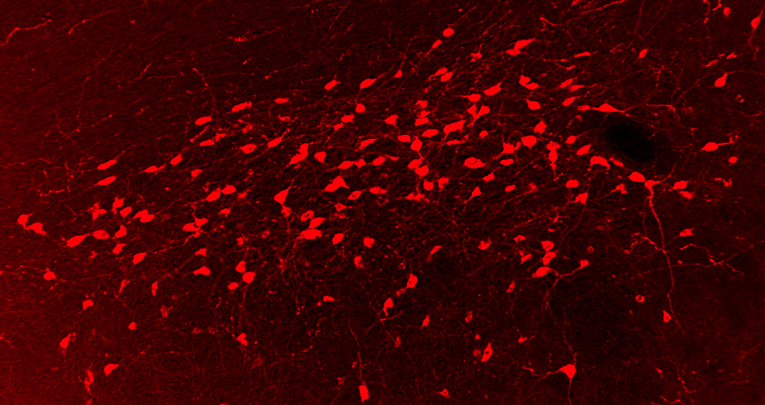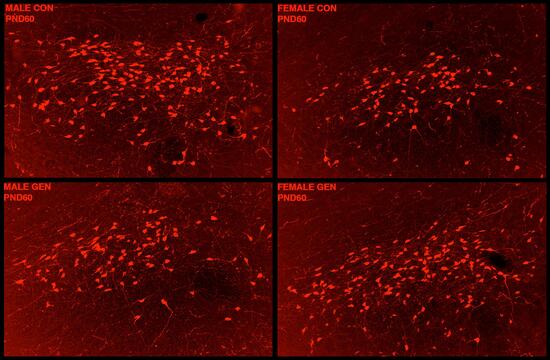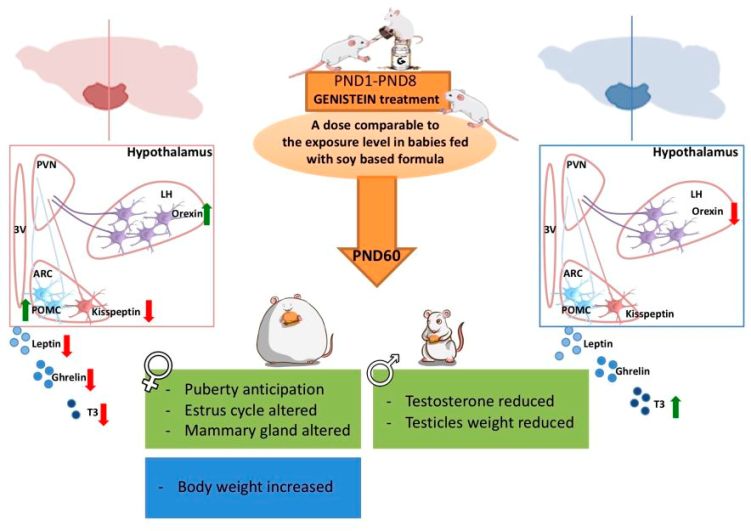
Metabolites , 10 luglio 2021
Early Postnatal Genistein Administration Affects Mice Metabolism and Reproduction in a Sexually Dimorphic Way
Marilena Marraudino, 1 Giovanna Ponti, 1 Chantal Moussu, 2 Alice Farinetti, 1,3 Elisabetta Macchi, 4 Paolo Accornero, 4 Stefano Gotti, 1,3 Paloma Collado, 5 Matthieu Keller, 2,† and Giancarlo Panzica 1,3,*†
Abstract
The phytoestrogen genistein (GEN) may interfere with permanent morphological changes in the brain circuits sensitive to estrogen. Due to the frequent use of soy milk in the neonatal diet, we aimed to study the effects of early GEN exposure on some physiological and reproductive parameters. Mice of both sexes from PND1 to PND8 were treated with GEN (50 mg/kg body weight, comparable to the exposure level in babies fed with soy-based formulas). When adult, we observed, in GEN-treated females, an advanced pubertal onset and an altered estrous cycle, and, in males, a decrease of testicle weight and fecal testosterone concentration. Furthermore, we observed an increase in body weight and altered plasma concentrations of metabolic hormones (leptin, ghrelin, triiodothyronine) limited to adult females. Exposure to GEN significantly altered kisspeptin and POMC immunoreactivity only in females and orexin immunoreactivity in both sexes.
Orexin system . Photomicrographs showing the distribution of Orexinimmuno stained cells in the lateral hypothalamus (LH) of adult CD1 mice of bothsexes. In control animals, this system is sexually dimorphic, with male shaving a significantly higher number of cells than females, the dimorphism completely disappeared in GEN-treated mice.
In conclusion, early postnatal exposure of mice to GEN determines long-term sex-specific organizational effects. It impairs the reproductive system and has an obesogenic effect only in females, which is probably due to the alterations of neuroendocrine circuits controlling metabolism; thus GEN, should be classified as a metabolism disrupting chemical.
Keywords: phytoestrogens; endocrine disruptor; dimorphism; obesity; kisspeptin; POMC; orexin
read full article
Early postata exposure of mice to GEN determines long-term sex-specific organizational effects.
Mice of both sexes were postnatally treated with GEN (50 mg/kg body weight, comparable to the exposure level in babies fed with soy-based formulas). When adult, we observed, in GEN-treated females, an advanced pubertal onset and an altered estrous cycle, and, in males, a decrease of testicle weight and fecal testosterone concentration (green squares). Furthermore, we observed an increase in body weight and altered plasma concentrations of metabolich ormones (leptin, ghrelin,triiodothyronine T
3
) limited to adult females. Exposure to GEN significantly altered kisspeptin and POMC immunore activity only in females and orexin immunor activity in both sexes (blue squares).
1
Neuroscience Institute Cavalieri Ottolenghi (NICO), Regione Gonzole 10, Orbassano, 10043 Torino, Italy
2
UMR Physiologie de la Reproduction et des Comportements, Institut National de Recherche pour l’agriculture, l’Alimentation et l’Environnement (INRAE), Centre National de la Recherche Scientifique (CNRS), Institut Français du Cheval et de l’Equitation (IFCE), Université de Tours, 37380 Nouzilly, France
3
Laboratory of Neuroendocrinology, Department of Neuroscience Rita Levi Montalcini, University of Torino, Via Cherasco 15, 10125 Torino, Italy
4
Department of Veterinary Sciences, University of Torino, Largo Braccini 2, Grugliasco, 10095 Torino, Italy
5
Department of Psychobiology, Universidad Nacional de Educación a Distancia (UNED), C/Juan del Rosal 10, 28040 Madrid, Spain
*
Author to whom correspondence should be addressed.
†
Equally contributed and should be considered as joint senior authors.









